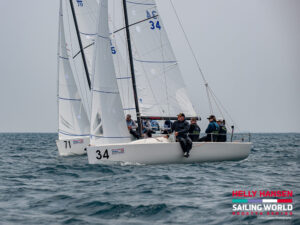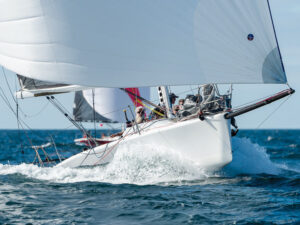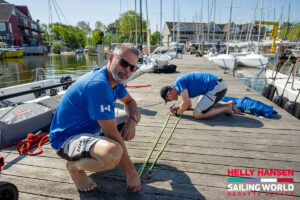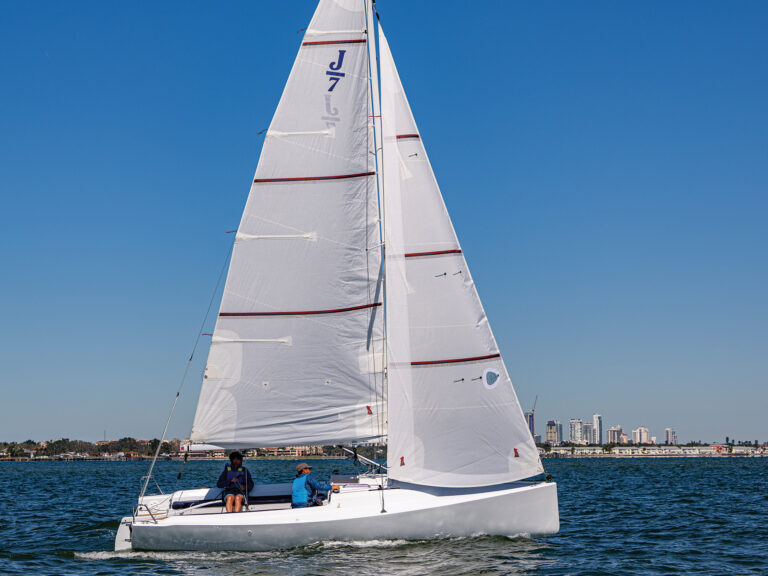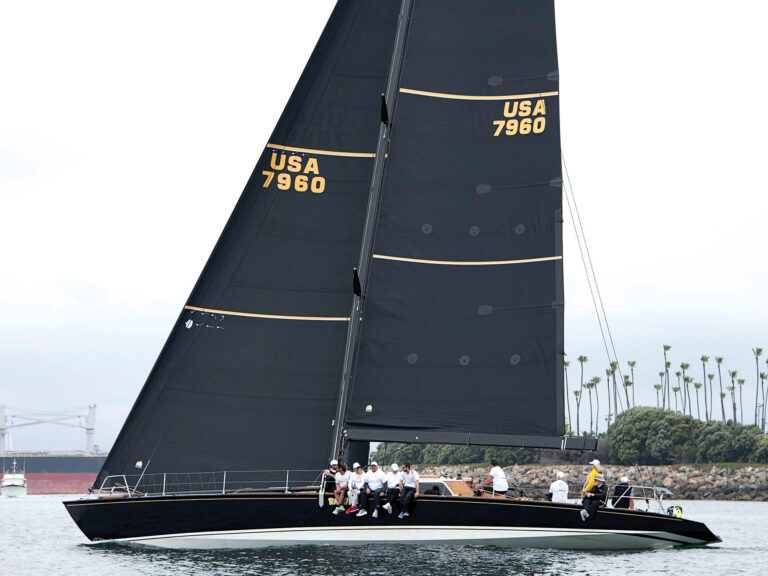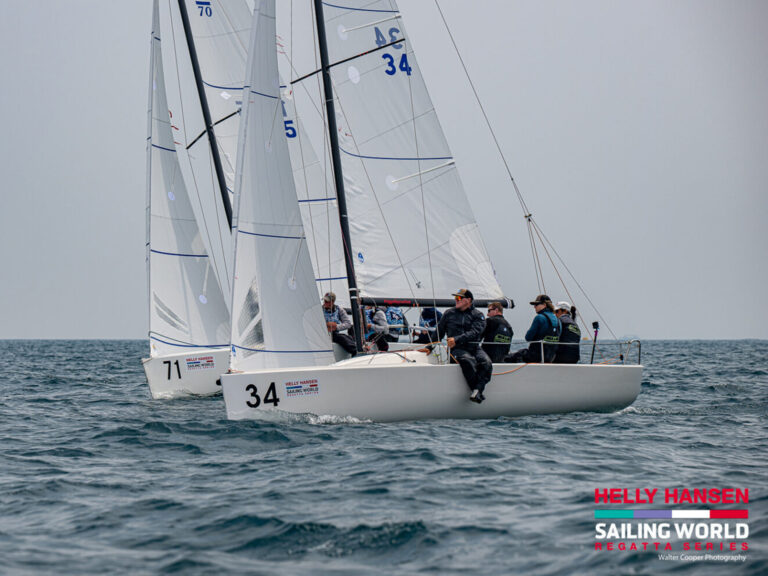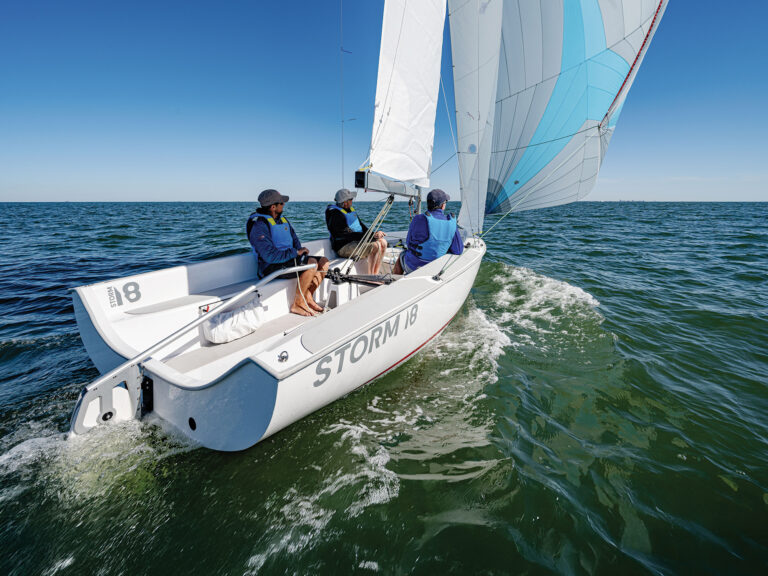
FTEBalance368
Large sailboats that carry lead or ballast for static stability have long suffered from their maximum speeds. Until recently, smaller dinghies and catamarans running on windward-leeward courses, and thus sailing square when going downwind, have been similarly limited to modest maximum speeds. At these modest speeds the dynamic forces involved in the turn of the boat have been minimal. As a result, the dynamic technique of steering for balance has never been a core subject in either sailing tuition or the sailing media.
Over recent decades, however, small sailboats have become capable of maintaining greater downwind speeds, and an increasing number of big catamarans and water-ballasted or swing-keel monohulls have adapted skiff technology, allowing them to sail much faster than before. This speed treble has elevated the steer-for-balance technique from one of negligible importance to that of absolutely vital. At high speeds especially, steering for balance works brilliantly–no other technique is better.
Some years ago I coached several mature and experienced sailors on the 59er, and I was astonished to find that so many of them were unaware of the steer-for-balance principle. More accurately, most thought they knew what it meant–and that they would be able to use it naturally, if and when it became necessary. But when faced with real speed and a sudden gust they turned the boat the wrong way and simply “lost it.”
Recent experience with larger numbers and a wider age and experience range of sailors on the simulator has confirmed this. [Ed.’s note: Bethwaite helped develop a sailing simulator that has been used for training purposes; see Sailing World, March 2005.). Only a handful of experienced sailors know how to control a sailboat at speed and get peak performance while doing so. Most top sailors believe they know what steer-for-balance is, and they believe they can do it. But when put to the test, they don’t know and they cannot do it.
Like turning downwind for equilibrium, steering for balance is simple. If a boat, which is sailing with centerboard down, is turned sharply left, it will roll to the right, and vice versa. This enables a crew to steer for balance with a technique identical to that of the cyclist-i.e., if the boat rolls to its left, a turn to the left “steering the hull under the rig” will bring it upright. This property is dynamic and increases as the square of the boatspeed. It becomes significant at modest speeds–10 knots for example–and becomes dominant and overrides all other forces at high speeds.
The dynamics at play
Imagine you are looking, from astern, at a light outboard motorboat moving away from you at speed. If the coxswain turns the bow sharply left, the hull will slide across the water to its right; water will heap up under the starboard chine and the boat will roll downward to the left.
If a sailboat with no centerboard is turned similarly, it too will roll to the left, but if the centerboard is down it will roll the other way. The centerboard turns with the hull and develops a strong force to the left.
This force acts several feet below the water through the center of pressure of the centerboard. The boat’s mass is represented by its center of gravity, and this mass, at speed, wants to continue on its trajectory. The boat is being accelerated to the left at low level by the centerboard while inertia at a higher level is resisting the acceleration with a force to the right. Thus, a hard turn to the left will roll the boat to the right. Use of this principle is fundamental to steer for balance.
This roll force is negligible at the 6-knot speed of a conventional dinghy or yacht, so in the example above where a gust heels the boat and it rounds up to the left automatically, but at low speed, the roll force toward the right is not an issue. At the 15- to 20-knot speed of an apparent-wind sailing skiff it will be about 10 times greater (the roll force increases as the square of boatspeed) and will have become dominant.
Using the motorboat example again, imagine it’s a skiff sailing away from you at 20 knots; the crew are at their maximum hiking or trapezing positions. The boat encounters a gust, which causes the boat to heel to the right despite the crew easing its sheets. Further action is called for to survive.
The common reaction is to turn left and let the boat round up into the wind. This course of action has three problems: First, any turn to the left at this speed will roll the boat further and strongly to the right, resulting in capsize. Second, any turn to the left will be a turn upwind, which will lead to an increased apparent wind, further heeling, and greater capsize possibilites. The third reason is that if this is a race situation and the mark on a broad reach is ahead and somewhat downwind, any turn to the left will be a turn away from the mark and will win no race.
The second option is to turn the boat to the right, which has three advantages: First, a turn to the right at speed will roll the boat strongly to the left and this will bring the heeled boat immediately upright. Second, by turning downwind, the apparent wind is reduced. Third, the boat will still be sailing fast, under control, and directly toward the mark.
Option No. 2 is variously referred to as “steering for balance,” “steering the hull under the rig,” or, “when sailing downwind, turn downwind in the gusts.” If you’re one of the many sailors who has never thought about this, and have never done it (and most sailors haven’t), then think about it, and try it. The rewards are enormous. This technique is the key to controlling any fast boat downwind.
Making balance natural
The ideal way to learn the steer-for-balance technique is to sail in a breeze in a fast boat with somebody who can do it and have them coach you until it becomes an automatic response, like riding a bicycle. If this isn’t possible, you can learn to do it yourself by approaching it logically. In doing so, you’ll likely need to overcome established habits at two levels as you learn.
The quickest way to learn is to use the technique to roll the boat. Set up on a heading on which you can sail as fast as you can. In lighter winds this will be on a beam reach; in stronger winds it will be on a broad reach. Trim sail to maximize speed, and then turn abruptly downwind 10 degrees (one hand at arm’s length subtends an angle of 10 degrees). The boat will roll to windward.
Turn upwind, and then downwind through an arc of 15 to 20 degrees. The rate of turn, and the amount of turn that gives the greatest roll in that boat at that speed, will quickly become apparent. Nothing will happen if you waggle the tiller quickly, but when you combine the optimum frequency to turn back and forth with the most effective rate of turn and amount of turn, you can roll a fast boat at speed in a strong wind to the point of capsize.
As you become fluid you can sail even faster by adjusting your sail trim despite the turns. To do this, ease your sheet as you turn downwind and vice versa. In practice this means you will work your arms in opposite directions as you pull the tiller extension hand toward your body to turn downwind.
As soon as you become familiar with this technique, think about what you are now doing. When the boat rolls to leeward, you are steering to leeward to roll it upright. So next time the boat is rolled to leeward by a gust, try steering sharply to leeward. The boat will roll upright–it’s that simple. It works equally well the other way. If, when sailing fast, the boat rolls to windward in a sudden lull, a sharp turn to windward before it loses speed will bring it upright. This is the art of steering for balance. One final note: if the centerboard is raised to extreme or removed, the steer-for-balance force reverses.
Ed.’s note: “Steer For Balance” is the first in a series of edited excerpts from Frank Bethwaite’s soon-to-be-published second edition of High Performance Sailing. The current edition is available through International Marine (www.mhprofessional.com).

